The Kombi Restoration pages.
The story of the Kombi starts in about 1988, my father bought
it from the original owner after it had suffered a moderately
severe front end collision. Although the suspension and chassis
rails were substantially undamaged the actual front of the car
was stove in considerably, the roof had major creases in it and
the driver side door was bent like a banana. The reason for my
father's interest in this vehicle was that it was just a bit
special, automatic, 8 seater, luxury interior and with the US
sourced semi-factory air-conditioning kit fitted, aside from the
accident damage it was in exceptional condition.
Some time after my father purchased it, a campervan that had
damaged its rear section became available, this vehicle was
purchased from the wrecker (after they had removed everything
they wanted from it) and became the donor for all metal north of
the front door locks and a large section of roof. By the wonders
of a cut-off wheel grinder and a mig welder my father found
himself the owner of a half yellow, half olive colour Kombi.
At this stage there was a temporary hiccup in the project as
he belatedly discovered that there is considerable difference in
the door hinge and lock mounts between apparently identical Kombi
vans. The disaster he had created for himself was threefold:-
The front hinge mounts did not allow the fitting of a door
that had the lock in a position to match the existing door frame.
The cutting of the two vehicles had been mildly inaccurate
leaving a huge gap at the bottom of the door and very large gap
between the rear of the door and the body frame.
The local wreckers were all out of Kombi doors in any case.
The Solution was to buy a pair of doors from "down south"
that fitted the hinge mounts, then using the angle grinder with
the cut-off wheel again, slice off the rear lock end of the doors
and replace it with the same section from the original doors.
During this process the lengths of the doors was fiddled with so
that they actually matched the body openings . Nothing was or
could be done about the gaps at the bottom of the doors, that
remains there to this day as a "tribute" to a "cut-and-shut"
job that should have had a bit more thought put into it prior to
metal being cut.
Finally the bits that had been worked on were repainted and
the van was driven under its own power into a shed at my parent's
house to await final putting back together (all trim, the side
door and sundry 1000 other things having been removed prior to
going to the body shop). There it sat until 1994 when Sylvia and I
decided to buy it and put it back on the road. At the time we
already owned an ex-army 2lt 9 seater bus and over the years I
had become moderately proficient at keeping VWs on the road.
I wish I had kept photos of the weekend we drove 400kms south
to Townsville to pick it up, my father and I spent several hours
swearing at the Kombi, the world in general and each other
persuading the poor thing to fire up for the first time in around
7 years to drive it onto a car trailer he owned at the time.
Several more hours were spent bolting doors and such on well
enough for the journey and loading around 3/4 of a ton (yes ton
not tonne) of spares (engines, gearboxes, electrical etc) into
the green bus. We then set sail in convoy for Cairns probably
causing more than a few laughs along the way.
At this point my saga of the yellow Kombi begins in earnest.
The first things I discovered were that trim panels do not
survive being left in a sealed shed in tropical north Queensland
200 metres from the sea. The next discovery was that neither does
metal. Whilst the external condition didn't look too bad, salt
had penetrated every crevice, crack, nook and cranny,
particularly around window and door seals. My first task was to
get the engine running well enough so that the vehicle could be
driven on permit to a body shop for the rust to be removed.
A couple of thousand dollars later, rust removed, hood lining
replaced, window frames rebuilt and new rubbers (where available)
fitted I was ready to resume the jigsaw puzzle of Kombi electrics.
Once the electrics all worked I re-made all of the interior
trim and kick panels, covering them in a tasteful black material.
For a bit of a diversion after that I replaced all ball joints
at the front, reset the rear suspension (removing and replacing
broken torsion bars is almost worthy of a story in itself),
rebuilt the front disk callipers and replaced the rear slave
cylinders.
Finally it went for a roadworthy inspection which it passed
due to the great Queensland tradition of "you are doing this
up for yourself aren't you mate, not to sell?" which meant
that it didn't quite have to comply exactly in a couple of areas.
At last on the road, but not for long.... The engine had
showed every sign of constantly running on the ragged edge
temperature wise, in spite of me carefully sealing up every hole
around the engine bay and carefully setting tappets and timing.
Finally after breaking two valve springs in two weeks (replaced
without removing the heads using a marvellous tool from Gene Berg)
it got so bad that I had to stop on my way to town (28kms) and
let it cool down, low compression having much to do with the
problem.
At the time Sylvia was working away about 250km out of town
and was not enjoying riding her motorcycle there and back once a
week, I decided to pull the good 2lt engine from our old Kombi
and put it in the new one. This fun little job was done over a
weekend on my own using only a floor jack, a bottle jack and
sundry lumps of wood, what fun we have when we are young....The
new engine smartened things right up, although it also
mysteriously ran hotter than I would have liked (I always mount
oil temperature sensors as close as possible to the outlet of the
oil cooler on the premise that knowing what temperature the oil
goes into the engine at is more useful than measuring it on the
way out) oil temps greater than 110 Celsius always worry me in VW
engines as it is close to the "magic" 125 degrees at
which most modern "consumer" oils start shearing and
breaking down. However I eventually decided to ignore it. About a
month later I found out why the engines in this car had always
run hot, the gearbox was frying them. I fitted a temperature
sensor to the pan of the automatic gearbox and immediately wished
that I hadn't, temps around 80 to 90 after only 20kms running,
climbing rapidly to 120 to 130 whilst climbing the hills,
something was seriously wrong. Shortly after the gearbox stopped
changing gear, out with jacks and lumps of timber, removed the
gearbox and took it to the local automatic gearbox experts.
$750 later the gearbox was rebuilt and the correct torque
converter was obtained. Part of the mystery of the high temps was
explained by the fitting of an Audi converter, dimensionally the
same, but with no "fan" on the back of it to pump air
over the converter to cool the fluid. Fitting the correct
converter lowered the temperature of the gearbox a staggering
amount and the engine by about 10 degrees, still hotter than I
would like.
| Here is a shot of the Kombi and family, prior to
Sylvia's restoration. I would have preferred a different
shot, but for some reason we cannot find any "before"
photos. When we eventually do, I'll put them here, |
 |
| This was taken the morning after the new Kombi's
arrival. For a brief period of time we were a two Kombi family. Along
with our two large BMW motorcycles and our trail bikes this caused our
neighbours to look at as askance and hide their children from us. |
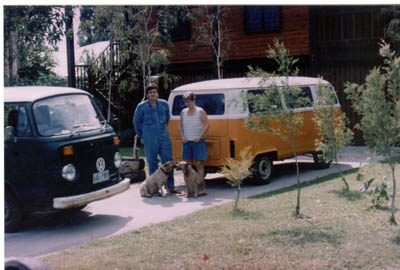 |
| And this is why it was never supposed to happen.
surely most females given this vehicle to drive around in
would have forsaken an old Kombi? |
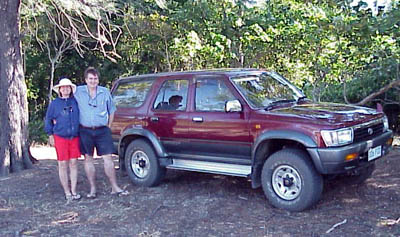 |
| The following shots were taken at the body shop and
show the degree of "deep" restoration required.
This photo reveals the mysterious blue paint found under
several layers of yellow. As the compliance plates for
the car indicate that it left the factory painted yellow
and as there is no evidence of accident repairs I can
only assume that it was painted blue at the factory and
then painted again, this time yellow.... |
 |
| |
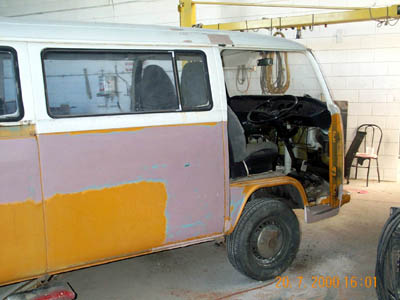 |
| |
 |
| This looks a bit more "spiffy" doesn't it. |
 |
| View from the front, along with a big giveaway that
something fishy is happening here. A radiator on a Kombi? |
 |
| View from behind the bullbar. The thematic fan was
probably a needless expense, it didn't turn on in 7km of
an average 1 in 6 grade. around town the engine appears
to be over cooled in spite of a fully functional original
thermostat. I am thinking of putting race tape over the
bottom third of the radiator to see if that brings it up
to temp. |
 |
| One Subaru EA82 engine, pretty much as it arrived
from East Keilor Wreckers, I've removed the air cleaner,
Alternator and Compressor to repair damage inflicted on
it by NQX a firm that will never carry my freight again
as long as I live. Fortunately when I sent photos of the
damage to East Keilor they replaced the damaged items for
the cost of postage. NQX didn't want to know me. By the
way, it left East Keilor strapped to a pallet and wrapped
securely in plastic, clearly labelled "top load only",
NQX put a lathe on top of it. In addition to the damage
already mentioned, the sump was flattened down to the
crank (beaten back out with a hammer and reused), the cam
belt covers were smashed (repaired with epoxy), one belt
cut part way through (were to be replaced anyway) and a
hole punched in one rocker cover (repaired with Devcom epoxy). Do not send freight with NQX
|
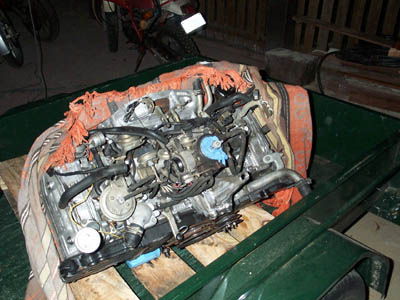 |
| A general shot of the EA82 in the Kombi engine bay,
fits very neatly although a little metal bashing was done
on the gearbox rear cross member to give "comfort"
clearance to the distributor. The fitting was done by
Vance Cooper of German Auto Parts in Cairns. Vance also
built a number of aluminium part-bulkheads around the
engine to deflect water from the engine bay. We did not
attempt to replicate the degree of sealing of the engine
bay with the original type IV engine.
|
 |
| A left/right shot of the engine mount fabricated by
Vance. I tried to talk him into taking a jig pattern of
the finished product to ease the manufacture of the next
one but he maintains that after two Subaru conversions he
is doing no more.. |
  |
| We decided to build another partial bulkhead around
the muffler so that heat did not radiate back at the cam
belt covers. In retrospect it was probably not needed,
but it looks neat. |
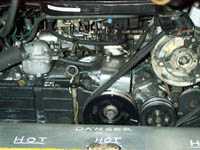 |
| The "Maniacal Painter" herself. For a few
weeks it seemed that anything left sitting for more than a few minutes got painted. Sylvia put enormous effort
into touching up lots of little things, although we did
fall out a little over my wrecking the paint freshly
applied to the tow ball when I used the Kombi to tow a
trailer into town (actually to deliver the old Type IV
engine to its new home).
|
 |
|
|
When I get more time I'll be putting the story of Sylvia's
restoration of our old Kombi van here.
For now either click your back button or click here to return














